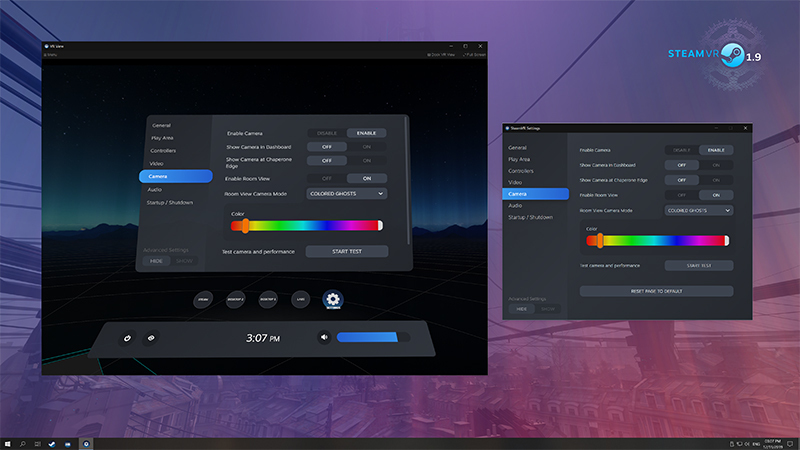Introducing SteamVR Version 1.9

Update Highlights
Today’s update features big improvements to Settings and Desktop, plus continued bug fixes and stability improvements.
SteamVR's new Settings interface offers improved usability and consistency between the desktop and in-headset experience. For instance, many settings that were previously only available on the desktop (such as refresh rate and render resolution) can now be controlled in-headset.
Desktop view now has enhanced performance, improved legibility, and supports multiple monitors.
Full Update Notes
SteamVR Settings
- Settings user interface re-design.
- Most settings now available on both the desktop and in-headset.
- Valve Index HMD refresh rate can be changed mid-game, without restarting. (Requires NVIDIA driver version 441, or higher)
SteamVR Desktop View
- Improved multi-monitor desktop support (Windows 10 only).
- Improved cursor rendering (Windows 10 only).
- Added experimental user setting to control Desktop scale.
- Fixed double characters appearing in the desktop view and Steam chat.
- Fixed backspace not working in the desktop view (Windows 10 only)
SteamVR
- Numerous crash fixes and stability improvements.
- Improved audio mirroring latency and fixed some cases where the mirror could accumulate a large delay.
- Moved Performance Graph to main SteamVR status window (right-click)
- Skip “Advanced Supersampling Filtering” for systems which use their own compositor (e.g. Windows Mixed Reality, Oculus). This fixes some causes of blurriness reported by WMR users.
- All windows now group together under one icon in the Windows taskbar.
- Fixed rendering of grid lines in the construct.
- Fixed loading animation on transition overlay being at the wrong height.
- Added better error diagnostics when failing to find proper display adapter for new UI.
- Added block compression to render model textures over 2048x2048.
- Minor optimization for motion smoothing.
- Fixed some memory leaks when VR_Init is called repeatedly in long-running applications.
- Increased the maximum number of overlays to 128.
SteamVR Dashboard
- Minor appearance tweaks.
- Fixed regression in ComputeOverlayIntersection for Dashboard overlays.
- Moved dashboard power menu from a tab to a popover.
- Added haptic bumps with moving on or off of buttons on the dashboard controls.
- Added experimental user setting to control Dashboard placement and scale.
SteamVR Input
- For games using legacy input: When fetching default bindings, prefer partner site explicit defaults instead of generic legacy defaults
- When switching bindings, SteamVR now records the previously selected binding in a setting.
- Action Sets with a higher priority will now correctly override sets with a lower priority.
- Recent games list in top level controller configuration menu now shows most recent game instead of starting with second most recent game.
SteamVR Home
- Added new colorizer tool to replace the color wheel while holding an object
- Fixed regression causing desktop view to not show up
- Fixed particles on wearables to not render for the wearer
- Changed map labels to go multi-line instead of truncate for a bunch of our maps (Summit Pavilion Remix - Evening, and many others)
- Change pickup/drop to allow picking up from either trigger or hand close on Index
- Fixed bug where waving the Index controller around while previewing teleport would cause the teleport to unintentionally happen
Linux:
- Rate-limit attempting to open the tracing filesystem to once every 5 seconds.
- SteamVR will now attempt to set thread priorities through rtkit (when available).
- Fixed a vrwebhelper crash that could make the dashboard disappear.
- Fixed the pairing UI window content not showing up the first time it was opened.
- Fixed a few behavior quirks in vrwebhelper's desktop windows.
- Added diagnostics for tracking down rare stuck haptics bug on Linux.
Oculus:
- Fixed an issue where controllers may stop tracking too quickly when hidden from view.
- Fixed IPD value not being correct until changed by the user.
Index HMD
- Max brightness extended to 140.
- Framerate can be changed without restarting (requires NVIDIA driver version 441, or higher).
Requires firmware update.
SteamVR Tracking 2.0 Basestations
- Improved reliability of firmware updates, in situations with weak signals or interference.